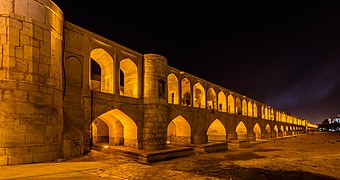|
Si-o-se-pol
The Allahverdi Khan Bridge (Persian: پل اللهوردی خان), popularly known as Si-o-se-pol (Persian: سیوسهپل, lit. '[the] bridge of thirty-three [spans]'),[1] is the largest of the eleven historical bridges on the Zayanderud, the largest river of the Iranian Plateau, in Isfahan, Iran.[2] The bridge was built in the early 17th century to serve as both a bridge and a dam.[3] HistorySi-o-se-pol was built between 1599 and 1602,[4] under the reign of Abbas the Great, the fifth emperor of Safavid Iran. It was constructed under the supervision of Allahverdi Khan Undiladze, the commander-in-chief of the armies, who was of Georgian origin, and was also named after him.[5][6] The bridge served particularly as a connection between the mansions of the elite, as well as a link to the city's vital Armenian neighborhood of New Julfa.[1] In years of drought (2000–02 and 2013), the river was dammed upstream to provide water for Yazd province.[6]
StructureThe bridge has a total length of 297.76 metres (976.9 ft) and a total width of 14.75 metres (48.4 ft). It is a vaulted arch bridge consisting of two superimposed rows of 33 arches, from whence its popular name of Si-o-se-pol comes, and is made of stone. The longest span is about 5.60 metres (18.4 ft).[4] The interior of Si-o-se-pol was originally decorated with paintings, which were often described by travelers as erotic.[1] Gallery
Transportation
See alsoReferences
Further reading
Wikimedia Commons has media related to Si-o-se Pol. |
||||||||||||||||||||||||||||||||||













